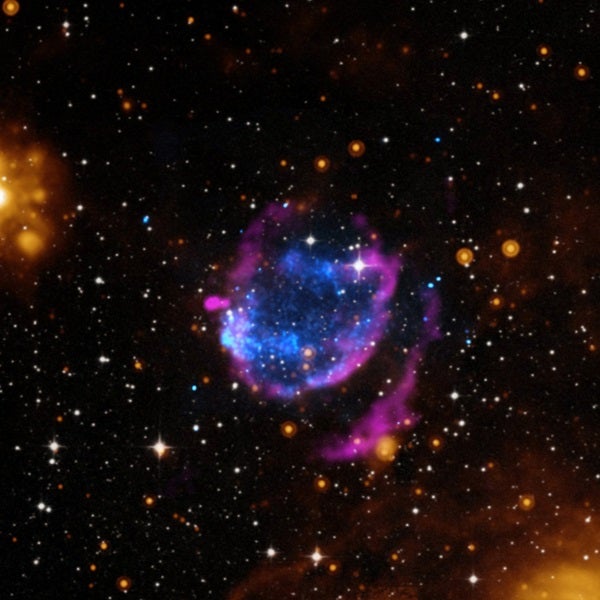Astronomers have identified a supernova remnant that has several unusual properties. First, they found that this supernova remnant, known as G352.7-0.1 (G352), has swept up a remarkable amount of material, equivalent to about 45 times the mass of the Sun.
Another atypical trait of G352 is that it has a very different shape in radio data compared to that in X-rays. Most of the radio emission is shaped like an ellipse, contrasting with the X-ray emission that fills in the center of the radio ellipse. This is seen in a new composite image of G352 that contains X-rays from NASA’s Chandra X-ray Observatory in blue and radio data from the National Science Foundation’s Karl G. Jansky Very Large Array in pink. These data also have been combined with infrared data from the Spitzer Space Telescope in orange, and optical data from the Digitized Sky Survey in white. (The infrared emission to the upper left and lower right are not directly related to the supernova remnant.)
A recent study suggests, surprisingly, that the X-ray emission in G352 is dominated by the hotter (about 54 million degrees Fahrenheit [30 million degrees Celsius]) debris from the explosion, rather than cooler (about 4 million degrees F [2 million degrees C]) emission from surrounding material that has been swept up by the expanding shock wave. This is curious because astronomers estimate that G352 exploded about 2,200 years ago, and supernova remnants of this age usually produce X-rays that are dominated by swept-up material. Scientists are still trying to come up with an explanation for this behavior.
Although it does not produce a lot of X-ray emission, the amount of material swept up by G352 is remarkably high for a supernova remnant located in our galaxy. This may indicate that a special type of evolution has occurred in which the massive star that exploded to create G352 interacted with an extraordinary amount of dense surrounding material.
Astronomers also conducted a search for a neutron star that may have been produced by the supernova explosion. They did not find any hints of a neutron star in G352, another astronomical puzzle involved with this system. One possibility is simply that the neutron star is too faint to be detected or that the supernova created a black hole instead.
G352 is found about 24,000 light-years from Earth in the Milky Way Galaxy.










